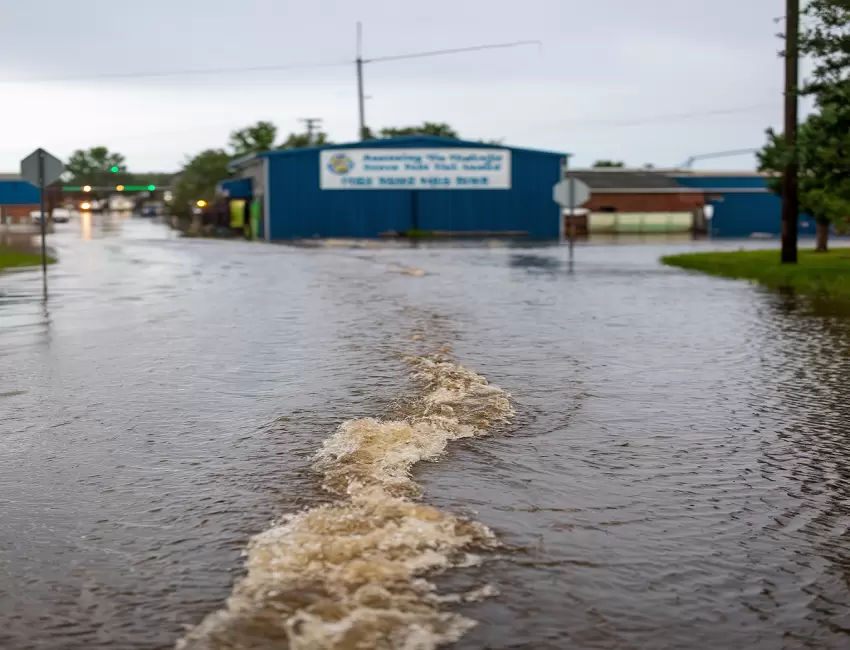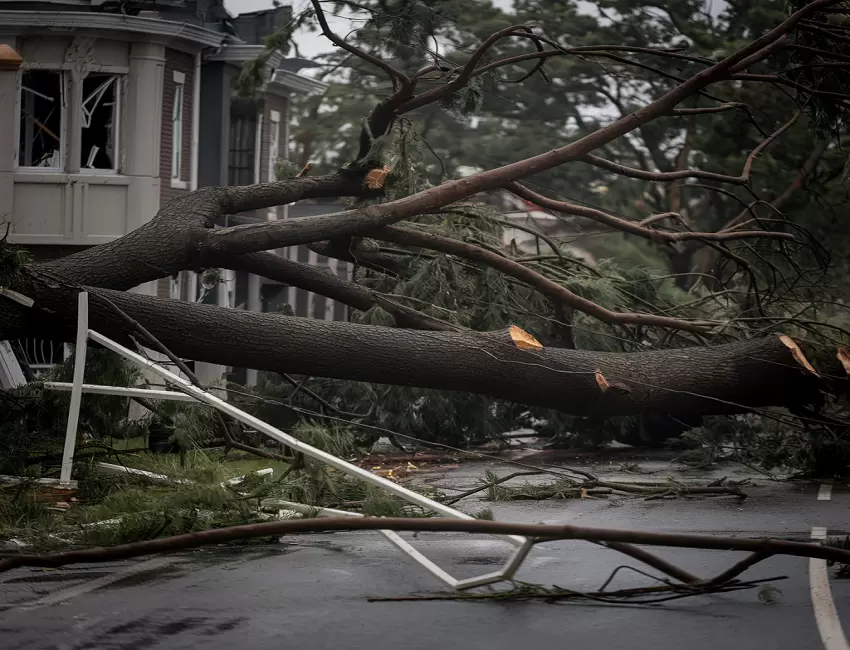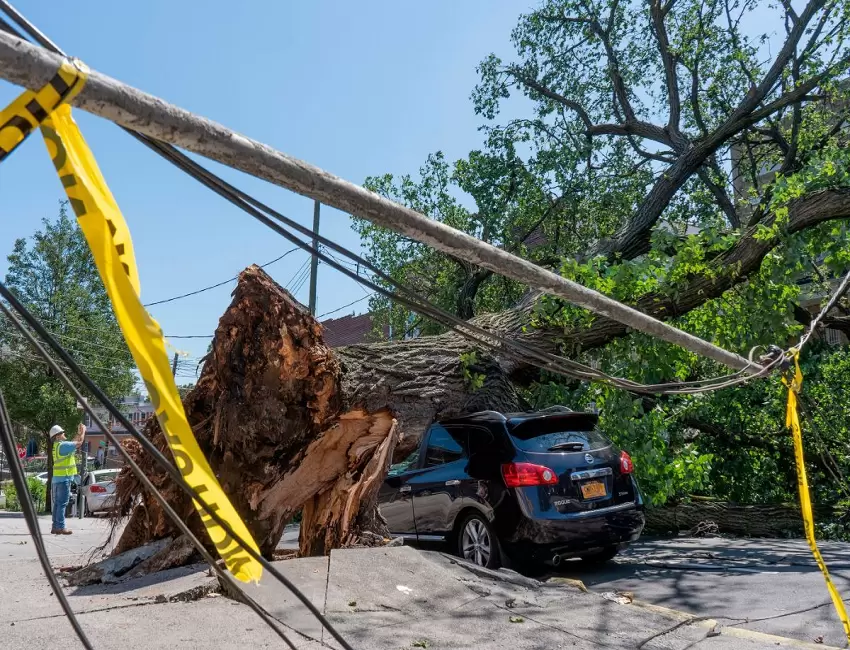Drive in extreme winds conditions is one of the most difficult weather conditions that a motorist encounters. With a blow toss from mother nature it becomes even more complicated.
Whether you are on a coastal road or traveling across a vast plain, knowing what to do with your car when the wind begins to howl will help you avoid serious accidents.
With this knowledge and skill set, you will be able to cope with high winds confidently and securely.
The Hidden Dangers of Extreme Winds
Picture this: With music on and moving along the highway, there’s this moment where your car begins to drift off course. It’s like the steering wheel has a will of its own and every stroke.
I make seems to encourage it to move even further away from my destination branches of trees beside me are shifting as if they wanted to get closer than necessary.
This scenario, all too familiar to those who’ve experienced driving in wind, illustrates why this topic matters to every driver.
Extreme winds pose unique challenges that can catch even experienced drivers off guard. They can:
- Push vehicles out of their lanes
- Cause sudden loss of control
- Create hazardous debris on the road
- Rollover hazards can be enhanced particularly with respect to publicized displacement.
The very first step that you can take towards ensuring safety when driving in windy conditions is to know the risks associated with such weather.
Understanding Wind Speed and Its Impact on Driving
Let’s first explain what are the problems with “extreme winds” and how they influence our automobiles moving on the highway before we get deep into the details of driving through a very difficult climate.
Wind Speed Classifications
Beaufort scale is used by meteorologists to categorize the speed of winds. Here’s a simplified version relevant to drivers:
| Beaufort Number | Wind Speed (mph) | Description | Effects on Driving |
| 0-3 | 0-12 | Light air to gentle breeze | Minimal impact |
| 4-5 | 13-24 | Moderate to fresh breeze | Noticeable wind, some steering correction needed |
| 6-7 | 25-38 | Strong breeze to near gale | Difficult driving conditions, high-sided vehicles at risk |
| 8-9 | 39-54 | Gale to strong gale | Dangerous for all vehicles, avoid driving if possible |
| 10+ | 55+ | Storm to hurricane force | Extreme danger, do not attempt to drive |
When Wind Becomes Dangerous
The point at which wind speeds become dangerous varies depending on the type of vehicle you’re driving Generally:
- For cars: Winds above 35 mph require extra caution
- For high profile vehicles (trucks, RVs, etc.) Winds as low as 25 mph can be problematic
- For motorcycles: Even moderate winds (15-20 mph) can significantly affect stability
The Aerodynamics of Wind vs Vehicle
Wind interacts with vehicles in complex ways. In strong winds, the handling of your car is greatly influenced by its profile, mass distribution and even color (dark cars absorb heat more thus changing air pressure around).
Key factors include:
- Crosswinds: These hit your vehicle from the side, potentially pushing it out of its lane.
- Tailwinds: While they might seem helpful, they can mask your actual speed and affect braking distances.
- Headwinds: These slow you down and can increase fuel consumption.
Understanding these interactions helps you anticipate and react to wind effects while driving.
Assessing the Risks: When to Stay Off the Road

Sometimes, avoiding driving altogether is the most prudent choice of action. But how do you make that call?
Weather Forecasting and Wind Advisories
Our access to weather information is never before experienced in the history of modern technology. Before heading out:
- Check local weather reports
- Look for wind advisories or warnings
- Use weather apps that provide hourly wind forecasts
Pro tip: When winds persistently blow at 40 mph or more during gusts up to 58 mph the National Weather Service issues “High Wind Warnings”.
Recognizing High-Risk Scenarios
Certain areas are more prone to dangerous wind conditions:
- Coastal regions: Prone to strong sea breezes and storm-related winds
- Mountain passes: Can funnel wind intensifying its speed
- Open plains: Offer no natural windbreaks
- Urban canyons: Unpredictable wind tunnels may occur due to tall structures.
While deciphering your excursion, discovering part of these zones, it would be wise to consider deferring your adventure or finding another way around.
Vehicle-Specific Considerations
Not all vehicles handle wind the same way. Consider your vehicle’s profile:
- High-profile vehicles (SUVs, vans, trucks): More susceptible to being pushed by wind
- Compact cars: Lighter weight can make them vulnerable to strong gusts
- Electric vehicles: Generally, they have a smaller center of gravity that assists them in keeping their balance.
Case Study: A twenty mile an hour wind would raise the chances of accidents involving high sided vehicles by twenty-five percent according to a study published in Journal of Wind Engineering and Industrial Aerodynamics in 2015.
Pre-Drive Preparations: Drive in Extreme Winds
In front of you blowing across the road, preparation is a great way to improve your safety while driving in the wind.
Vehicle Maintenance Checks
Upkeep is always important but it’s even more vital when facing but not limited to bad climate. Here’s a checklist:
- Tire pressure: Ensure all tires are properly inflated
- Windshield wipers: Replace if worn (wind often comes with rain)
- Lights: Check that all lights are functioning
- Brakes: Ensure they’re in good condition
- Suspension: Have it checked regularly for optimal handling
Benjamin Franklin said, “An ounce of prevention is worth a pound of cure.”
The truth of this saying is particularly relevant in terms of car service in difficult driving situations.
Securing Loose Items
Wind can turn everyday objects into dangerous projectiles. Before driving:
- Secure any external cargo with sturdy straps
- Remove roof racks if not in use
- Clear your vehicle of debris (leaves, twigs) that might blow off
- Ensure all doors and windows are properly closed
Planning Your Route with Wind in Mind
Smart route planning can help you avoid the worst of the wind:
- Check wind forecasts along your entire route
- Identify alternative routes that might offer more protection
- Plan for extra travel time to account for slower speeds
- Locate safe stopping points along the way
Remember road safety often starts before you even turn the key.
Mastering Driving Techniques in Strong Winds

Since you are well-prepared, let’s go into the techniques that will ensure your safety on the road while the wind howls.
Grip and Steering Adjustments
In high winds, your usual steering techniques might not cut it. Here’s how to adapt:
- Hold the wheel firmly: Use both hands in the 9 and 3 o’clock positions
- Be ready to correct: Wind gusts can push your vehicle suddenly
- Avoid overcorrecting: Small, smooth movements work best
Tip: Imagine you’re driving on ice smooth, deliberate movements are key.
Speed Management and Braking Distances
When it comes to speed in windy conditions, less is more:
- Reduce your speed: This gives you more time to react
- Increase following distance: Wind can affect stopping distances
- Be especially cautious when exiting sheltered areas: Sudden gusts can catch you off guard
Dealing with Sudden Gusts and Wind Direction Changes
Wind is rarely constant. Here’s how to handle its unpredictable nature:
- Stay alert: Watch for signs of gusting wind (trees moving, debris on the road)
- Both hands on the wheel: Always be ready to correct your course
- Expect the unexpected: Wind direction can change rapidly, especially around obstacles
Passing Other Vehicles Safely
Passing in strong winds requires extra caution:
- Allow more space when passing, especially high-profile vehicles
- Be prepared for a push when you emerge from the other vehicle’s wind shadow
- Consider if passing is necessary sometimes it’s safer to stay put
Bold fact: Studies show that wind related accidents are more likely to occur during passing maneuvers.
Navigating Specific Road Scenarios
Different road environments present unique challenges in windy conditions. Let’s break them down.
Bridges and Overpasses
These elevated structures are particularly vulnerable to extreme winds:
- Slow down before reaching the bridge
- Be prepared for sudden gusts as you enter or exit
- Watch for warning signs many bridges have wind advisories
Open Highways vs. Urban Areas
The contrast between these environments can be stark:
Open Highways:
- Less protection from wind
- More consistent wind direction
- Higher overall wind speeds
Urban Areas:
- Buildings can create wind tunnels
- Unpredictable wind directions
- Potential for more wind-blown debris
Adapt your driving style accordingly as you transition between these areas.
Mountain Roads and Valleys
Mountains create complex wind patterns:
- Be alert for sudden gusts around bends
- Watch for falling rocks or debris
- Use lower gears to maintain better control
Coastal Drives
Coastal areas often experience strong, consistent winds:
- Be aware of salt spray reducing visibility
- Expect stronger winds as you approach the coast
- Watch for sand or water on the road
The Role of Technology in Wind Safety
Modern technology offers valuable tools for driving in extreme conditions.
Wind-Specific Driving Assistance Features
Many newer vehicles come equipped with features that can help in windy conditions:
- Electronic Stability Control (ESC): Helps maintain directional control
- Crosswind Assist: Automatically applies brakes to counter wind effects
- Lane Keeping Assist: Helps prevent wind from pushing you out of your lane
Apps and Tools for Real-Time Wind Monitoring
Leverage technology to stay informed:
- Weather apps with wind speed and direction data
- Navigation apps that include weather overlays
- NOAA Weather Radio app for official warnings
How GPS Can Help You Avoid High-Wind Areas
Smart use of GPS can enhance your safety:
- Plan routes that avoid high-risk areas
- Use real-time traffic updates to identify wind-related slowdowns
- Some advanced systems can even suggest alternative routes based on weather conditions
If You’re Caught in a Severe Wind Event

Despite our best planning, sometimes we find ourselves in unexpectedly severe conditions. Here’s what to do.
Finding Safe Shelter on the Road
If winds become too extreme to drive safely:
- Look for sturdy structures (overpasses, parking garages)
- Avoid stopping under trees or power lines
- If possible, orient your vehicle with the front facing the wind
Emergency Procedures for Wind-Related Accidents
If the worst happens:
- Stay calm and assess the situation
- Turn on hazard lights
- Call for emergency assistance if needed
- Stay in your vehicle unless it’s unsafe to do so
What to Do if Your Vehicle is Damaged by Wind Debris
Wind-blown objects can cause significant damage:
- If safe, move your vehicle off the road
- Document the damage with photos
- Contact your insurance company
- Don’t attempt to drive if the damage affects your vehicle’s safety systems
The Aftermath: Post-Strong Wind Driving Checklist
After navigating through strong winds, take these steps:
Inspecting Your Vehicle for Wind Related Damage
Conduct a thorough check:
- Look for dents or scratches from debris
- Check tire pressure and condition
- Inspect windshield and mirrors for cracks
- Test all lights and signals
Reporting Hazards and Damaged Infrastructure
Be a good citizen:
- Report fallen trees or power lines to local authorities
- Alert highway patrol to any road damage you’ve noticed
- Share information about hazardous areas with other drivers through apps or social media
Reviewing and Improving Your Wind-Driving Strategy
Reflect on your experience:
- What worked well?
- What could you improve?
- Are there new skills you need to develop?
Use this reflection to enhance your preparedness for future wind events.
FAQ:
Q: At what wind speed should I avoid driving altogether?
A: Generally, avoid driving when winds exceed 50 mph. However, for high-profile vehicles, even 35 mph can be dangerous.
Q: How can I tell if it’s too windy to drive safely?
A: In case you are not able to pay attention what is going on around you, use your phone to check the upcoming weather or advisories about wind. Don’t even think of driving if walking straight is not something you can do.
Q: What’s the best way to handle sudden strong gusts while driving?
A: Hold tight on the driving wheel let go of your acceleration gradually and do soft minor adjustments. Avoid oversteering and be prepared for directional changes.
Conclusion: Empowering Yourself as a Wind-Savvy Driver
Operating a vehicle under extreme circumstances, especially during strong gusts, requires one to demonstrate respect for nature’s forces to be fully prepared and to stay alert at all times.
By taking into account how wind interacts with one’s car in collisions, proper pre-trip arrangements can be made; learning some special driving tricks helps grow personal skills; adopting up-to-date technological advancements also helps lessen dangers experienced in driving due to wind.
Remember the key takeaways are:
- Always check weather forecasts and wind advisories before traveling
- Prepare your vehicle properly for windy conditions
- Adapt your driving techniques to the specific wind conditions you encounter
- Know when it’s safer to delay your trip or seek shelter
In this time of climate change that might cause severe weather patterns such as strong winds, the importance of these abilities is increasing. It is essential to know what is happening, be ready for any situation, and above all, ensure your safety while driving.
Your turn: Yeah! Who can forget those times when we were driving downhill experiencing very strong winds? Someone should tell me how they did it in other countries.
Comment here if you have any other stories or suggestions about this topic. Let us create a community of wind wise drivers prepared for anything that nature throws our way.

With over 5 years of dedicated experience in the automotive industry, I am passionate about all things automotive. My journey began with a deep curiosity for automobiles, which led me to delve deeper into their mechanics, technology and trends. My expertise spans various aspects of the automotive world, from the latest electric vehicles to classic car restoration techniques. Through my articles, I aim to share my knowledge and insights, helping readers stay informed and inspired in the fast-paced world of the automobile.











